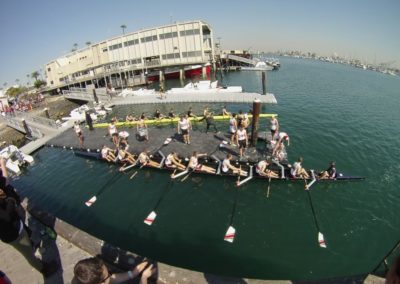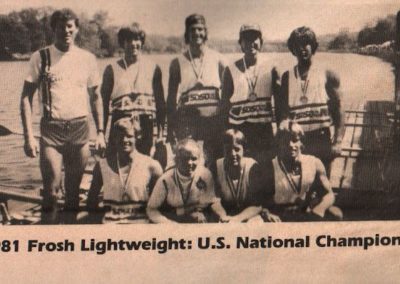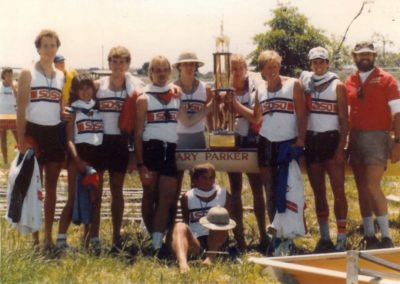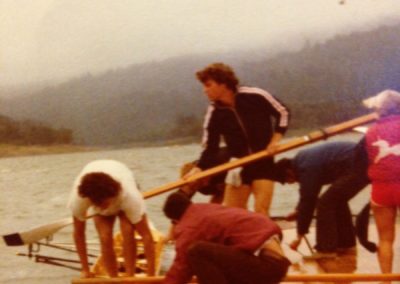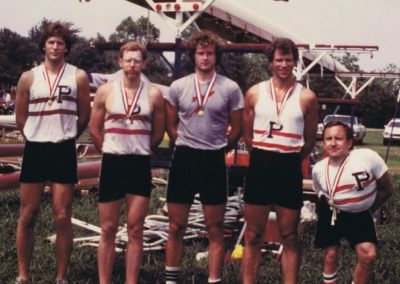Crew at San Diego State is the oldest sport on campus…
having begun in 1899 at what was then called the San Diego Normal School. Teams were fielded off and on for decades until the 1960s when H. Del Beekley (after whom our Rowing Center was named) became the Coach and started up a large, permanent team. State has fielded a team ever since with – tremendous success in each decade.


Along the way, the SDSU Men have won dozens of dual races, numerous cup races, and team points trophies at races up and down the West Coast.
Aztec crews have earned medals at regattas in the East, including the largest collegiate regatta, the Dad Vail Regatta in Philadelphia, the men’s national championship at the Intercollegiate Rowing Association, and the world famous Royal Henley Regatta on the Thames river in England.
It can be said that rowing in San Diego dates back as far as the discovery of San Diego Bay – given the importance to commerce of navigating the Bay – but rowing as a sport began here in earnest around the middle of the 19th Century.
The San Diego Rowing Club was created by local enthusiasts in 1888. After a decade of rowing out of smaller structures, the rowing Club’s original boathouse was constructed in 1899.
The year before, women from what was then called the “San Diego Normal School” (a teacher’s college that was the precursor to SDSU) began rowing out of the Rowing Club. When the San Diego Normal School merged with San Diego Junior College in 1921 to form San Diego State Teachers College, men began representing the College almost immediately by rowing out of the Rowing Club.
The group of Aztecs who raced during the early-to-mid ’70s included an amazing group of athletes. Competing for SDSU during that timeframe were Jeff DeBoer, Tim Watenpaugh, John Fahrner, Bryan Traynor, John McNab, Joe Flohr, Brad Geis, and Kelly Rickon (Coxswain) – to name a few.
From this group, three U.S. National Team rowers emerged: Tim Watenpaugh rowed on the U.S. Pan American Games team in the 4, Kelly Rickon was a Coxswain for the U.S. Women, and Steve Estes earned a seat in the U.S. National Lightweight 8.
1977 Season

In the spring of ’77, Tim Watenpaugh and Jeff DeBoer (with Kelly Rickon as their Coxswain) took the Silver Medal at the I.R.A. in Syracuse in the 2+ event. After rowing again as members of MBRA that fall, a 4+ (Bryan Traynor, Joe Flohr, John Farhner, Tim Watenpaugh, and Coxswain Kelly Rickon) went to the Western Sprints and won Gold. At the end of that era, in the spring of ’78, Watenpaugh teamed with John Farhner and once again raced in the 2+ on Lake Onondaga in Syracuse (the I.R.A.).
1978 Season
In the Fall of 1978 the Aztec undergraduates who were involved in rowing on Mission Bay were rowing in fall regattas as members of the Mission Bay Rowing Association (M.B.R.A.). They had no coach, but between the excellent group of athletes who had rowed in the late ’70s and an extraordinary group of novice who were rowing for M.B.R.A., a new Coach Doc Perez (who had rowed at Cal) saw that there was a great potential for boat speed. He “took the Aztecs away from M.B.R.A.” almost immediately and began operating year round as a college – and only a college – team. An already existing pride in their school reenergized the Aztecs and they charged into the future with the battle cry, “No Excuses!”
But there was something else … something more than a pre-existing pride and a specific group of athletes already rowing. Those involved in the program at that time began to realize the depth of the pool of athletic talent that walked across the campus at State. Then – as now – SDSU possessed perhaps the most athletic group of students of any university or college in America (and, thus, the entire world). Raised in the California, outdoors, sports-and-fitness-oriented culture, the student body of San Diego State presents to the largely walk-on sport of crew more fit, powerful, strong, and talented athletes than the student body anywhere else. All that had to happen was for recruitment to expand and for the team to double and then to triple in size. And so it did – almost immediately.
1979 Season
In the 1979 spring season, an incredible turn-around occurred involving the Varsity Heavyweight 8. It was a mixed group in terms of experience and temperament, but they were all fiercely competitive people who created a hard work-oriented culture that would pay dividends in boat speed immediately.
Coxed by a feisty, 100-pounds-soaking-wet Freshman Teresa Hagman, this amazing crew was stroked by Senior and soon-to-be Freshman Coach Russ Young. This ‘turn-around’ crew (the season before had included zero victories) also included Bryan Traynor ( a polished veteran with four years of experience rowing with the likes of Watenpaugh, DeBoer, Fahrner, Peters, and Rickon) at 7, John Barr (a powerful, mountain-of-a-man Novice) at 6, Allan Miller (an experienced transfer from U.C.L.A.) at 5, Steve Bickler (a Novice – now Dr. Steve Bickler – after whom our Scholar-Athlete of the Year Award is named) at 4, Brad Geis (an internationally known body surfer) at 3, Joe Flohr (eventually the Head Coach at the University of San Diego) at 2, and John McNab (today a community activist in San Diego)/Dan Williams (who pulled double duty that year as a lightweight in the engine room of the first Aztec Lightweights of the era) in the Bow.
This crew began to turn things around for State in their first spring race, when they dominated USC in L.A. Harbor. When the season was over, they had come in second in the Cal Cup at the San Diego Crew Classic, defeated Stanford, defeated Santa Clara, defeated St. Mary’s, defeated Long Beach State, come in second at the Western Sprints in Los Gatos, and collected numerous shirts and medals. That year too, the seeds were sown for an Aztec Lightweight program that would soon dominate the Western United States.
In the fall of 1979, the Aztecs raced as SDSU instead of MBRA for the first time. They were so successful so quickly that only one year later the Aztecs were able to win the Team Points Trophy at the Head of the Harbor.
The Varsity boat continued to grow faster over the course of the season. The Novices (now coached by graduate Russ Young) included many future Aztec greats including Kurt Bausback, Ed Ecker, Tom Riggs, and Craig Killman. And the Lightweights began to do some damage in the West, defeating Cal for the first time.
1981 Season

In 1981, an extraordinary group came together in the Varsity Heavyweight 8. Still Coxed by Teresa Hagman, it was stroked by Bill Lawson, with Carl Wallace at 7, John Barr at 6, Tom Riggs at 5, Ed Ecker at 4, Kurt Bausback at 3, Mark Leeds at 2, and Charlie Bradley in Bow.
There have been faster crews in Aztec history – measured on the stop watch – but this crew was the “winningest” crew ever.
They won the:
- Head of the Harbor Open 8 in the fall, the Reed Cup at the City Championships
- “B Flight” Varsity 8 at Opening Day in Seattle
- Cal Cup in front of thousands of fans on West Mission Bay
- Placed 2nd at the Western Sprints
Mark Leeds doubled up at several points in the season, as had Dan Williams before him, rowing in the engine room at #6 in the Lightweight Varsity, which again defeated Cal AT Cal on the Oakland Estuary as a part of the historic Cal-Washington dual meet.
The icing on the cake of the 1981 season occurred when the entire Lightweight program Varsity 8, JV 8, and Frosh 8 went to Philadelphia to race in the Dad Vail Regatta, the small college National Championships. While the two Varsity boats did remarkably well, the Aztec Freshmen won the National Championship for Lightweight Freshman 8s by open water!
1984 Season

The 1984 Varsity was the fastest San Diego State Crew of all time in its day.
They defeated every single W.I.R.A. crew by 9 seconds or more. They won the Head of the Harbor’s Open 8 in the fall, the Reed Cup at the City Championships, the Parker Cup against Irvine (for the first time ever) and Loyola-Marymount, and every dual meet that year. They came in a close third in the Petite Final of the Copley Cup at the Crew Classic, a scant 6 seats behind U.C.L.A.
By the end of the year in 1984, the racing in Sacramento at the Western Sprints (involving 30+ crews – as it still does today) was distilling down into two questions:
First, would Cal or Washington win the Gold Medal?
Second, could San Diego State win the Bronze medal – a first for a W.I.R.A. crew – by defeating U.C.L.A.?
In winning their heat on Saturday morning, the Aztecs defeated everyone by three boatlengths and more but they were the unfortunate victims of an “inappropriate” call by the officials.
The race course that year did not have buoys in a line the way it does today. Instead, those who were then developing the race course placed large “Hippity Hops” anchored in place each 250 meters. When an over-pull moved the Aztecs out of their lane (they were three lengths ahead of the crew in the lane that they “violated”), they were disqualified from the final, even though they clearly were the class of the field – defeating every crew by a substantial margin (our 8 was open water ahead of everyone after only the first 250 meters!).
And so, this most successful of years ended without the chance for the long awaited race against U.C.L..A. In the crew were J.J. Jinguigi, Craig Killman, Leif Olsen, Brian Webster, Scott Diener, Gregg Buckley, Claude Hooten, Scott Petry, and Ken Kerry.
The Lightweight 8 of 1984 lost to Washington in the Finals of the Western Sprints in Sacramento, in a seat-for-seat, down to the last stroke race in front of a roaring crowd. It would be just one year later that the Lightweights defeated everybody at Sacramento, went back East to defeat Yale, ended up the season ranked 5th in the country, and went on to race at the Henley Royal Regatta!
1985 Season
 By that time, the team had expanded out in every direction and was turning in championship level performances all across the board.
By that time, the team had expanded out in every direction and was turning in championship level performances all across the board.
The Lightweights continued their run of West Coast supremacy, and defeated Washington, Cal, and everybody else on the West Coast at Sacramento in 1985. That crew went on to race back East, defeating Yale for the first time ever, and finished the season off with a trip to England to race in the Royal Henley Regatta.
That very same year, the team won the over-all points championship (for the fourth year in a row) in Sacramento at the State College and University Championships. The Aztec Novice dominated that regatta in ’85. Our first Novice 8 won the Gold Medal there, and the second Novice 8 won the Silver.
The following Aztecs have earned positions on United States Rowing teams:
| Name | Year | Regatta | Crew | Location |
|---|---|---|---|---|
| Steve Estes | ’77 | World Champs | Light Spare | Amsterdam, The Netherlands |
| ’82 | World Champs | Light 8 | Lucerne, Switzerland (7th) | |
| Brian Lewis | ’79 | World Champs | Light 8 | Bled, Yugoslavia (2nd) |
| Tim Watenpaugh | ’79 | Pan Am Games | 4- | San Juan, Puerto Rico (2nd) |
| Allan Miller | ’81 | World Champs | Light 8 | Munich, Germany (5th) |
| Tom Bowman | ’81 | World Champs | Light 8 | Munich, Germany (5th) |
| Doug Perez | ’81 | World Champs | Lt. 4- Coach | Munich, Germany (9th) |
| Marisa Giangrasso-Barge | ’82 | Canadian Henley | W. Light 8 | World Record Time |
| Kurt Bausback | ’83 | Pan Am Games | 4+ | Caracass (GOLD) |
| ’84 | European Tour | Various | Multiple Regattas | |
| ’85 | World Champs | 8 | Hazewinkle, Belgium (3rd) | |
| ’86 | World Champs | 4+ | Nottingham, U.K. (3rd) | |
| ’86 | Good Will Games | 4+ | Moscow (2nd) | |
| ’87 | Pan Am Games | 8 | Indianapolis (GOLD) | |
| ’88 | Olympic Games | 2- | Seoul, Korea (9th) | |
| Scott Erwin | Pan Am Games | |||
| Aaron Pollock | ’91 | World Champs | 2+ | Vienna |
| ’92 | Olympic Games | 2+ | Barcelona (8th) | |
| Tom Hartley | ’90 | World Champs | Lt. 4- | Tasmania (7th) |
| ’91 | World Champs | Lt. 8 | Vienna (3rd) | |
| ’92 | World Champs | Lt. 8 | Montreal (7th) | |
| Scott Petry | ’87 | World Champs | Lt. 8 | Copenhagen (3rd) |
| Garrett Klugh | ’99 | World Champs | 4+ | St. Catherines (GOLD) |
| ’00 | World Champs | 4+ | Zagreb, Yugoslavia (2nd) | |
| ’01 | World Champs | 4- | Lucerne, Switzerland (4th) | |
| ’02 | World Champs | 8 | Seville, Spain (3rd) | |
| ’03 | World Champs | 4- | Milan, Italy (7th) | |
| ’04 | Olympic Games | 4- | Athens (20th) |
If you have info or photos to share please send an email to SDSUMensRowing@gmail.com








